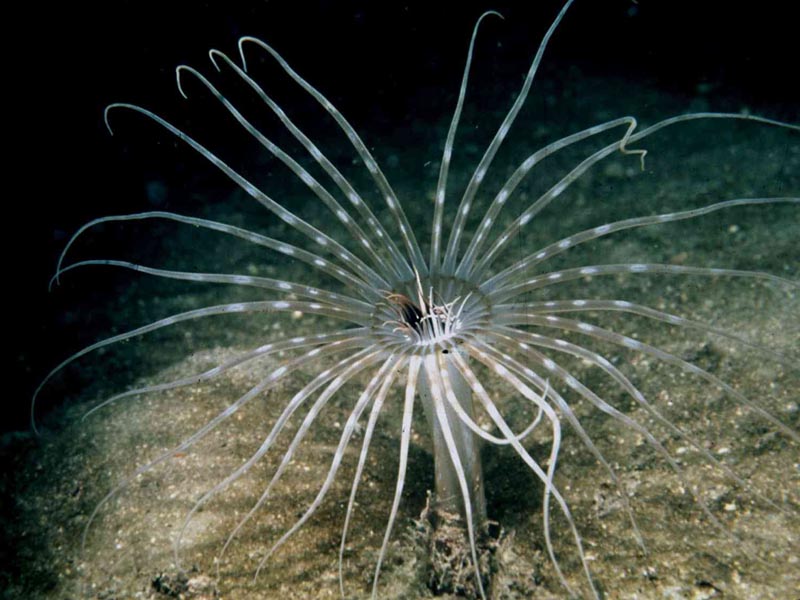Scarce tube-dwelling anemone (Arachnanthus sarsi)
Distribution data supplied by the Ocean Biodiversity Information System (OBIS). To interrogate UK data visit the NBN Atlas.Map Help
| Researched by | Emily Wilson | Refereed by | Admin |
| Authority | Carlgren, 1912 | ||
| Other common names | - | Synonyms | - |
Summary
Description
A large sea anemone, up to 20 cm high when fully expanded, that lives in a tube in the seabed. The tentacles are white-grey or pinkish in colour, often with diffuse brown bands. They are arranged in two cycles of 30 long outer and 30 shorter inner tentacles. The inner tentacles point inwards and upwards to form a cone and are dark brown on the inner surface. It is similar to Synarachnactis lloydii but Arachnanthus sarsi is much larger and has fewer tentacles. The cone of inner tentacles is distinctive and readily distinguishes this species from Synarachnactis lloydii. It may be partly nocturnal.
Recorded distribution in Britain and Ireland
Recorded only on the north coast of Ireland, the west of Scotland and the Hebrides.Global distribution
This anemone was originally described from Norway, but no other distribution information was found.Habitat
Lives in a parchment-like tube in mud, sand or shelly mud sediment at 10-36 mDepth range
10-36Identifying features
- Column long and slender, capable of great contraction, obvious aboral pore.
- Marginal tentacles rather stout forming single series at periphery of disc, from 30-34.
- Labial tentacles slightly longer than radius of disc when expanded, arranged in single series and point inward and upward to form cone.
Additional information
May be conspecific with Arachnactis albida.
Listed by
Bibliography
Bourne, G.C., 1919. Observations on Arachnactis albida. Quarterly Journal of Microscopical Science NS, 64 (253), 27-65.
Eleftheriou, A. & Basford, D.J., 1983. The general behaviour and feeding of Cerianthus lloydii Gosse (Anthozoa, Coelenterata). Cahiers de Biologie Marine, 24, 147-158.
Howson, C.M. & Picton, B.E., 1997. The species directory of the marine fauna and flora of the British Isles and surrounding seas. Belfast: Ulster Museum. [Ulster Museum publication, no. 276.]
Hughes, D.J., 1998a. Sea pens & burrowing megafauna (volume III). An overview of dynamics and sensitivity characteristics for conservation management of marine SACs. Natura 2000 report prepared for Scottish Association of Marine Science (SAMS) for the UK Marine SACs Project., Scottish Association for Marine Science. (UK Marine SACs Project). Available from: http://ukmpa.marinebiodiversity.org/uk_sacs/pdfs/seapens.pdf
JNCC (Joint Nature Conservation Committee), 1999. Marine Environment Resource Mapping And Information Database (MERMAID): Marine Nature Conservation Review Survey Database. [on-line] http://www.jncc.gov.uk/mermaid
Manuel, R.L., 1981. British Anthozoa. London: Academic Press.[Synopses of the British Fauna, no. 18.]
Picton, B. E. & Manuel, R.L., 1985. Arachnanthus sarsi Carlgren, 1912: a redescription of a cerianthid anemone new to the British Isles. Zoological Journal of the Linnean Society, 83, 343-349.
Picton, B.E. & Morrow C.C., 2005. Encyclopedia of Marine Life of Britain and Ireland http://www.habitas.org.uk/marinelife/species.asp?item=D10920, 2008-01-08
Wood. C., 2005. Seasearch guide to sea anemones and corals of Britain and Ireland. Ross-on-Wye: Marine Conservation Society.
Datasets
NBN (National Biodiversity Network) Atlas. Available from: https://www.nbnatlas.org.
OBIS (Ocean Biodiversity Information System), 2025. Global map of species distribution using gridded data. Available from: Ocean Biogeographic Information System. www.iobis.org. Accessed: 2025-08-15
Citation
This review can be cited as:
Last Updated: 03/09/2007



